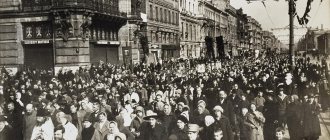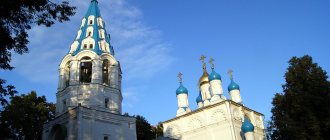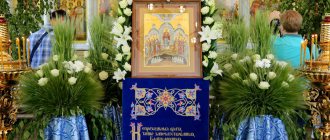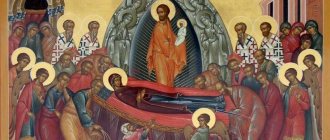Sedmiezernaya Icon of the Mother of God
The miraculous image of the Mother of God appeared at the call of numerous prayers during a terrible time for people, when a pestilence raged in Rus'. For showing the miracle of healing, the holy image was glorified among the Orthodox people.
The Seven Lakes Icon of the Mother of God has enormous fame among believers who sacredly honor church traditions. The image of the Holy Mother contains great miraculous power, capable of delivering from any illness of soul and body, coming to the aid of everyone who bows before her in prayer.
The Seven Lakes Icon of the Blessed Virgin Mary is also popularly known as the “Smolensk Hodegetria”. A huge number of Christians from all over the world revere this shrine, admiring its miraculous deeds.
History of the icon
Mainly, the icon is a symbol and sacred relic of the monastery, which is called the “Sedmiezernaya Bogoroditsk Hermitage”. In the 17th century, the monk Euthymius transferred the holy image there from Veliky Ustyug. There were several small lakes in that place, which eventually formed one large lake. On its bank a monastery was built, called Sedmiezerny, hence the corresponding name of the icon of the Mother of God.
The shrine brought with it many miracles then. People who lived in the vicinity of the monastery prayed before the Sedmiezernaya icon with requests for help and support of the Mother of God. In 1654, a terrible epidemic broke into the capital of our homeland, claiming a huge number of lives. Soon the plague came to all the big cities of Russia. People died in severe agony due to the disease that struck them. City residents hid in forests and fields. Then the rulers decided to move the Sedmiezernaya icon from the monastery to Kazan, hoping that the miraculous image could protect them from death.
A few kilometers from Kazan, a huge number of people marched in a procession led by an icon of the Mother of God in the name of saving the entire city and country. The miraculous icon was carried around Kazan and placed in the Annunciation Cathedral. People began to walk around the houses of Kazan with the icon, praying for salvation. Gradually the plague began to recede, and soon subsided completely.
After the divine salvation of the entire country, the miraculous accomplishments of the shrine did not stop. It became known all over the world, and every believer sought to see with their own eyes the sacred Sedmiezernaya Icon of the Mother of God.
Where is the miraculous image of the Mother of God located?
As you know, the shrine was moved to the Moscow Annunciation Cathedral immediately after saving the country from a ferocious disease. Several times the icon was transferred back to Kazan, and then again to Moscow.
Currently, the original Sedmiezer image of the Mother of God is kept within the walls of the Peter and Paul Cathedral in Kazan. The most famous and revered copies of this icon can be found in the Smolensk Assumption Cathedral and in the Novospassky Stavropegial Monastery in Moscow.
Description of the Sedmiezernaya Icon of the Mother of God
The Sedmiezernaya Icon contains the image of the Mother of God. The Blessed Virgin is depicted wearing a maforia, her traditional robe that covers her head and most of her body. In the arms of the Mother of God is the Savior, the tender gaze of her eyes is directed at him. The fingers of her right hand are folded in a prayerful gesture, which expresses love, faith and gratitude to the Lord, thereby indicating to people that only in trusting and turning to the saints lies true prosperity.
How does a miraculous image help?
The shrine can perform various miracles, surprising people with its divine deeds. But the most amazing thing is that this icon is capable of healing from the most severe, terrible and deadly disease. She has the power to heal an entire city and even a country.
In front of the holy image of the Mother of God of Seven Lakes, they pray for deliverance from various kinds of epidemics, flu, ulcers and other diseases. Also, the icon can heal from emotional experiences, bitterness, resentment, fear, hatred and sadness.
Days of celebration
The Orthodox Church has set aside three days a year for the veneration of the sacred icon. The celebration dates are June 26 (July 9, new style), July 28 (August 10), and July 13 (October 26).
Prayer to the Mother of God before the icon
“Oh, Lady of Heaven! Mother of our Savior! Most Holy Theotokos, we pray to You and cry to You for help! We ask You, Virgin Mary, for the cleansing of our souls, for the remission of our sins and for Your support and protection! Protect us from serious and painful diseases. Deliver us from illnesses and heal our souls from anxiety and sorrow! Only You alone, our Intercessor, is capable of filling our hearts with love and faith. Forgive us for our wicked actions, guide us on the righteous path, fill us with light and goodness, O Great Mother of God. Come to our aid and do not leave us in troubles and misfortune. For before Your icon we pray, kiss the cross of the Lord and repent for sinful deeds. We glorify Your name every day and praise all Your miraculous deeds. In the name of the Father, and the Son, and the Holy Spirit. Forever and ever. Amen".
Icons of the Mother of God are the property of Orthodoxy and quick helpers in moments of despair and pain. The Mother of God is the saint closest to the prayers of believers, not forgetting a single request addressed to her. According to the strength of your faith and love for the Almighty and all the saints, help will overtake you. We wish you happiness.
take care of yourself
Other information[ | ]
Art critic Irina Buseva-Davydova wrote that a number of copies of the icon have a peculiarity: the gesture of the Mother of God’s hand was gradually replaced by a traditionally pointing one: the motif of patronizing overshadowing became a blessing, and often with the two-fingered sign of the cross. The Sedmiezernaya icon enjoys special veneration among the Old Believers. Gradually, a unique iconographic version called the Mother of God “Sedmiezernaya” [6] arose and strengthened in Russian culture of the 15th–19th centuries.
There is a version about the appearance of the iconographic version of the Mother of God “Sedmiezernaya” due to the influence of the Byzantine-Italian school on Russian icon painting[7].
The frame of the Sedmiezernaya Smolensk icon is lined with white and bright blue beads.
Most honest Cherub...
The Sedmiezernaya Icon is one of the icons that enjoy extreme veneration in the places where it is located. The day of celebration in her honor is a celebration not only for the Sedmiezernaya Hermitage and Kazan, but also for the entire Kama Volga region.
At the end of the 16th century, in the city of Ustyug, Vologda province, Evfimy was born into a poor family. From a young age, he felt within himself a desire for spiritual achievements. He left his father's house early and retired to a monastery. Having buried his parents, he moved to Kazan with his only inheritance - the Smolensk Icon of the Mother of God, where his brother also moved. 17 miles from the city, he chose a secluded place for himself, surrounded by seven lakes, which later merged into one. From these seven lakes the deserts he founded and his cell icon received the name “seven lakes.”
Having chosen this place, Euthymius fervently prayed to God and fell asleep when night fell. In a dream, he saw fire ascending into the sky from the place where he slept. Euthymius considered the dream a happy sign and erected a cross there, and built a cell for himself near it.
Not far from her stood an oak tree, considered sacred by the surrounding Cheremis. Here they made sacrifices - they slaughtered horses and oxen and hung their skins on a tree. Euthymius prayed to God to put an end to this abomination, and a storm came and destroyed the oak tree.
Rumors about the pious life of Euthymius gathered the brethren to him. Euthymius himself was taken to the Kazan Metropolitan House, where he took the icon with him. The brethren continued to turn to him for advice, so that he, not living in the desert, was still the leader and trustee of their needs.
No matter how much Evfimy valued the Smolensk icon - his parental blessing, however, out of his love for his brethren, he decided to part with it and bless the hermitage with it. At the request of Metropolitan Matthew, the Kazan clergy gathered to conduct the icon. When the prayer service was served, the Metropolitan, kneeling, exclaimed:
- You are leaving us, our Lady! Bless the desert into which You are going, and save those who live in it. But with them, look upon us with mercy, for our whole country, O Lady, trusts in Your name!
The Metropolitan ordered the priest and two deacons to accompany the icon to the desert, and many citizens followed them, both out of zeal for the Queen of Heaven, and out of a desire to see the newly emerging monastery. During the journey, some got tired, but as soon as they began to carry the icon, the fatigue stopped. The icon was joyfully received by the brethren of the monastery. After this, the people began to go to worship the shrine and bring donations to the hermitage. The wooden temple was replaced by a stone one, an abbess was established and another temple was erected in the name of the Smolensk icon, which was placed there to the left of the royal doors, where it remains to this day.
In June 1654, a pestilence or plague began in Russia, devastating entire villages. The corpses remained unburied and were devoured by dogs. Pestilence also raged in Kazan. The citizens decided to bring the Sedmiezersnaya icon to the city, and on June 24, with Abbot Pachomius, they arrived in the hermitage. The next day, after the liturgy, the icon was raised and set off for Kazan. On the night of this day, the nun of the Kazan monastery Mavra in a sleepy vision appeared to an old man in bishop's vestments, in every way similar to St. Nicholas the Wonderworker, and, touching her hand, said:
- Get up quickly and tell clerk Mikhail Patrikeev what you see, and he will tell the city governors and mayors to command the residents to fast for a week, repent of their sins and call on God and His Most Pure Mother for help.
Having said this, the man who appeared became invisible. The nun Mavra, waking up from sleep, was horrified and could not tell anyone about her vision, because it was night then. The next day, having stood at Matins, she did not fulfill the instructions given to her, but, having said a prayer, she lay down to calm down somewhat and fell asleep. And then again the same old man appeared to her in a dream vision and said to her with anger:
“Should you have slept, Mavra?” Or don’t you know that the city can die from a fierce ulcer? Get up quickly and go to the one whom I pointed out to you, and tell him: last night someone appeared to me twice and said that the Queen of all was coming to deliver the city from the Sedmiezernaya Hermitage. Let the mayors and all the residents of Kazan come out to meet Her image. For the Lord, for the sake of the prayers of His Most Pure Mother, wants to show mercy over this city.
The nun Mavra then hastened to tell the mayors about her dream. Upon announcement of this, the residents of Kazan, taking the miraculous Kazan Icon of the Mother of God, with a procession of the cross, everyone, young and old, left the city to meet the Smolensk Icon of the Mother of God, and two miles from Kazan they met it at the place where the Kizichesky Monastery now stands. They knelt down and prayed with tears, saying:
- Lady of the world, save us, we are perishing from our many sins; We have angered Your Son, Christ our God, with many of our iniquities.
It was a touching sight when the clergy and people, kneeling, cried and prayed before the image of the Mother of God!
On the same day, at this place, in memory of the meeting of the icon, a chapel was built and a cross was erected, and subsequently the Kizichesky Monastery was founded. The icon of the Mother of God was brought into the city by the residents at the Resurrection Gate and surrounded around the entire stone city. People came to venerate St. icon, and to consecrate it he bowed his head so that the shrine would be carried over them. Throughout the entire religious procession, the ringing of bells throughout Kazan did not stop. When they walked around the city with St. icon and brought it to the Annunciation Cathedral.
Through the prayers of the Most Pure Virgin, the deadly disease in the city subsided. The people, seeing their deliverance from death, brought thanks to the Queen of Heaven, their Deliverer.
In the evening of this day an all-night vigil was held. The next day, in the morning, they took the miraculous icon of the Mother of God with a procession of the cross and walked around the wooden city. During the procession of the cross, they saw that dark clouds had gathered outside the city, and above the city it was absolutely clear: “like some kind of barrier,” says the chronicler, “a hundred here and on both sides from the wrath of God.” This was taken as a sign of God’s mercy through the intercession of the Lady Theotokos. Then they began to carry the image of the Mother of God from house to house, performing prayers, and wherever there were sick people, there with the offering of St. icons they received perfect healing. When the Smolensk Icon was carried throughout the city and to all houses, the plague stopped completely.
Since that time, Kazan citizens have had a special faith and love for the Smolensk Icon of the Mother of God, located in the Sedmiezernaya Hermitage.
St. stayed for seven days. icon in the city. After this time, the monks of the Sedmiezernaya Hermitage asked the mayors to return St. icon in the desert. The mayors, after consulting with the clergy and citizens, although they did not want to part with the miraculous image of the Mother of God, by whose grace they got rid of a deadly disease, however, taking into account that this wonderful image was determined by the Divine vision to remain in the Sedmiezernaya Hermitage, they decided to release it from Kazan to the hermitage .
On the eve of the departure of the icon of the Mother of God, an all-night vigil was held in the cathedral and in all the churches of the city, and in the morning the residents of Kazan gathered in large numbers to see off their Intercessor. As soon as the Divine Liturgy was completed, St. icon, a terrible storm broke out over the city, darkness fell, rain and snow began to fall, so that it was impossible to leave the cathedral. This extraordinary phenomenon lasted not one, but three days.
From this they concluded that the Blessed Virgin did not want to leave the city, and they decided to keep St. the icon was left for a while longer, then the icon was returned to the hermitage. People began to resort to her even more diligently.
Metropolitan Corniliy, who arrived in Kazan at the end of 1654, seeing his flock saved by the intercession of the Mother of God from a deadly illness, thanked the Lord and His Most Pure Mother, approved the intention of the citizens to bring to themselves the miraculous icon of the Smolensk Mother of God and left it in Kazan for a whole year, after which , returning from the Moscow Cathedral, solemnly escorted her to the Sedmiezernaya Hermitage.
But soon after this, it was in 1656, on June 25, that the deadly disease reappeared in Kazan and began to rage more than ever. Citizens again brought St. icon from the desert to Kazan, believing in the quick help and intercession of the Most Pure Lady. Indeed, after bringing the icon, the illness stopped. Since 1658, it has been established forever to bring St. icon to Kazan on June 26, which is still being fulfilled. For the celebration of the transfer of the Sedmiezersnaya Icon from the desert, many people flock to Kazan not only from the surrounding provinces, but also from distant places. The icon is taken out of the desert on June 25 after mass; They stop for the night at the Kizichesky Monastery and proceed further in the morning after mass. In Kazan, another religious procession with icons and banners and with many people, officials and clergy awaiting the arrival of the icon beyond the Kazanka River. The fortress wall, the boulevard and both banks of the Kazanka are filled with crowds. Having met the icon, they serve a prayer service, and the bishop overshadows the east and west, south and north with it, and then, with the ringing of bells in all the churches of the city, the beating of drums and military music at Ivanovo Mountain, the procession passes to the cathedral and on the same day, in a certain sequence, they begin the icon wear around the city. On July 27, the icon was solemnly returned to the Sedmiezernaya Hermitage.
The Seven Lakes Icon, in addition to stopping the pestilence, was also famous for healing those sick with various diseases and the blind.
The Kazan commandant, General Castellius, suffered from such pain in his legs that he could not walk without the help of four people. Having tried medical remedies in vain, he decided to seek help from the Queen of Heaven. According to his position, he could leave the city only with special Highest permission, which was received on January 24, 1804. On the same day he was brought to the desert. Four brought him to the icon, to which he venerated. In the monastery room where he spent the night, the abbot invited him to anoint his feet with oil from the unquenchable lamp in front of the miraculous icon. The next day he listened to Matins, Liturgy and Akathist while standing on his feet. His situation kept improving, and after a few days he had the same control of his legs as before his illness.
azbyka.ru/days/ikona-odigitrija-sedmiezernaja
Notes[ | ]
- "Hodegetria" (Seven-Zero) icon of the Mother of God. Miracle-working icons of the Blessed Virgin Mary.
- Icon of the Mother of God “Hodegetria” Sedmiezernaya
- Grishechkina N.V.
The miraculous icon of the Mother of God of Sedmizernaya / Miracle-working icons in Russia. - Sedmiezernaya Icon of the Mother of God / The World of the Russian Icon.
- Venerable Elder Gabriel of Spaso-Eleazarovsky: life, exploits, miracles / author-comp. V. Gubanov. - M.: Russian Chronograph, 2006.
- Buseva-Davydova I. L.
Our Lady of Sedmiezernaya // The miraculous icon of Byzantium and Ancient Russia. - M., 1996. - Likhachev N.P.
Historical significance of Italo-Greek icon painting. The image of the Mother of God in the works of Italo-Greek icon painters and their influence on the compositions of some Orthodox Russian icons. - St. Petersburg, 1911.





